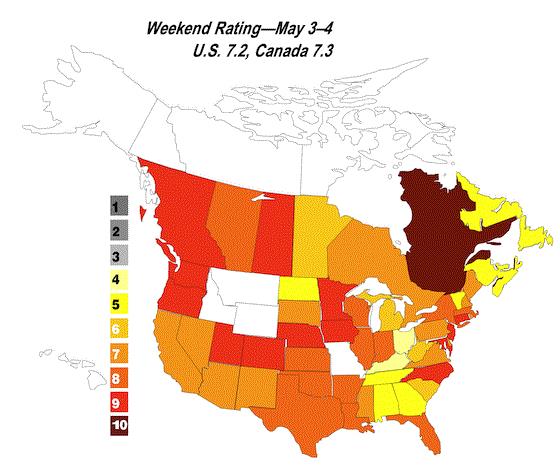How was May 3-4? Better than last year …
… but worse than the weekend before and slightly below average.
I’ll cut right to it: The first weekend of May was a disappointing 7.2 in the U.S. and 7.3 in Canada. As I said, that’s an improvement over 2024’s 6.6/6.9. And the 13-year average for the weekend is 7.6/7.4, so you weren’t too far off of that. But only 10% of you scored it a perfect 10, compared to 14% last year. It’s also down 0.3 points in the U.S. from last week’s 7.5, but dead on last week’s 7.3 in Canada.
Here’s the map:

That’s based on 112 scores from 44 states and 10 provinces.
A couple of notes: First, this has been Mother’s Day Weekend for five of the past 14 years, which throws off the average (the Mother’s Day average is 8.2/7.6, but that includes the three pandemic years of 2020, 2021 and 2022). The non-Mother’s Day average is 7.2/7.2, so really, you’re right where you should be.
Second, based on the relatively low number of perfect 10s, fewer of you than usual were satisfied with your sales. A lot more of you scored it 9 or 8 (15% each), while 19% of you scored it 7 and 10% of you scored it 6. Heck, another 11% of you scored it 5! That makes 40%—2 out of 5—calling the week/weekend pretty average to not good.

Where did you want to be doing business?
I’m pretty sure 100% of the negative comments revolved around weather. I can’t recall one that moaned about lack of customer interest. To the contrary, I think we’ve got an epidemic of cabin fever out there that only a trip to the garden center or nursery will cure.
Regionally, the Mountain states topped the list at 9.2, with the Pacific Northwest following close behind at 8.7. Lowest was the South at 6.7, followed by the West and Midwest, both at 7.0.
Skimming the list looking for states that received multiple scores, I see North Carolina with 7, 10, 10, 9; Iowa with 7, 8.5 and 10; Minnesota with 9, 9, 8.5, 9, 7; Oregon with 9.5, 9, 8; and Washington with 10, 9, 8, 7.
You did not want to be doing business in Kentucky (3, 5, 3), West Virginia (6, 5) or Alabama, (4, 6, 6). Ohio was mixed, at 2, 1, 9, for an ugly average of 4. I did note, however, that the business that gave it a 9 is closed on Sunday—which was the rainy day of the weekend.
Up in Canada, British Columbia, was PNW strong with 8.5, 8, 10; and Alberta scored 8.5, 8. Ontario sent the most scores (six), but only averaged 6.7, with scores ranging from a high of 8.5 to a low of 3 (from the north of the province). Quebec sent a single score (10), as did Saskatchewan (9).
The Atlantic provinces have made it up to 5, after weeks of scoring 1 or 2, so that’s a positive development! It can’t be too much longer before I finally hear from Nunavut and the Yukon!

A few cromulent comments
I picked out comments based less on the score and more on the market intelligence they offer:
New York (7). “Based on very strong sales in all departments on Saturday and Sunday morning, [we] were heading towards another 10. Rain started on Sunday at 1:00 p.m. and ended that hope.”—Sig Feile, Atlantic Nursery
Maryland (9). “We are closed Sunday, but would have thought Saturday was Mother’s Day Weekend. We hit a record customer count for any day, even Mother’s Day, for our 10 years in business. Except the hanging baskets didn’t disappear as quickly as they do on Mother’s Day, so our gross sales did not quite break records. You may bump this to a 10, as I don’t give 10s because I think there is always room for growth!”—Brian Martin, The Little Red Wagon Produce
Minnesota (9). “Hopefully, I ranked this weekend highly last year, too. Sun was shining, customers came out … and we were even with last year’s Friday, Saturday and Sunday sales. Customer count was up a bit, average transaction was down a bit.”—Derek Lynde, Lynde Greenhouse & Nursery
Oregon (9.5). “Delightful weather makes for delightful customers.”—Ed Blatter, Cornell Farm
Minnesota (9). “They say a picture is worth 1,000 words, and if I could share a picture of our current weather here in central MN, every garden center owner would understand my enthusiasm going into this week. Nothing, and I mean nothing, except full sun and mid-70s with favorable nightly low temperatures for the next 10 days. I scored this past weekend a 9; we did not topple records by 20%-plus (which is my requirement for a 10), but we certainly had a great first weekend in May.”—Jay Holasek, Fred Holasek & Son Greenhouse
Colorado (9.3). “Great weekend, perfect weather. Beat last year and looking forward to a great season.”—Gene Pielin, Gulley Greenhouse
Kentucky (3). “Torrential rains, hail and straight line winds Thursday through Sunday dealt a horrible blow to the greenhouses in our area. The widespread weather warnings all week long made everyone keep a watchful eye upon the weather conditions. Our home operation was not as severely impacted due to the increased volumes of succulents, cacti and houseplants, but our retail partners who depend upon the hanging baskets, bedding plants and potted plants suffered, which drastically reduced our wholesale volumes.”—Jesse Shelton, Shelton’s Greenhouses
Iowa (8.5). “Weather was the only thing that kept it from being a 9 or 10. Cool and cloudy, so we weren’t totally run, but very, very busy with great sales. Strong across all categories, especially annuals and perennials, with shrubs (hydrangeas) flying out the door, as well. Patio furniture starting to pick up with interest; I think some sun would make people pull the trigger. Forecast favorable with no rain and mid-70s all week. Looking for some records!”—Kate Terrell; Wallace’s Garden Center
Ontario (7). “Tricky one. It felt busier than we anticipated, yet compared with the same weekend last year it was dismal. So I guess this year we are happy with dismal ...?!”—Joanna Steckle, Steckle’s Produce & Flowers

What to do about tariffs (according to an AI chatbot)
Hearing that some folks expect us journalists to provide regular detailed updates on complicated, fast-moving topics like tariffs (nearly impossible even for The Wall Street Journal, let alone a lowly trade magazine), I cheated a bit for the next piece: I asked Grok (an AI tool) for some strategies a grower or garden center could employ to guard against tariff-induced supply chain disruptions and cost challenges. Here’s what he (she?) recommends, based on articles from dozens of respectable publications and websites (listed at the end):
Diversify suppliers. Source products from countries with lower or no tariffs, such as Vietnam, Mexico or India. For example, Vietnam has become a major supplier of goods like furniture and tools, replacing China in some sectors. Explore trade shows or platforms like Alibaba to identify non-Chinese manufacturers.
Localize procurement. Increase purchases from U.S.-based suppliers for items like pottery, mulch or basic tools, which are often produced domestically. This reduces tariff exposure and supports shorter supply chains, though it may come with higher costs.

Optimize inventory. Stock up on high-margin or essential Chinese-made items before new tariff hikes take effect, as goods in transit may be exempt for a short period. Use demand forecasting to avoid overstocking.
Pass costs strategically. Absorb some tariff costs to stay competitive, but pass a portion to consumers through modest price increases. Provide transparent communication, like cost breakdown charts, to explain price changes and maintain customer trust.
Explore tariff engineering. Modify product designs or sourcing to qualify for lower tariff rates. For instance, assembling products in a third country like Mexico could reclassify them as non-Chinese, reducing tariff exposure. Consult with customs experts or legal advisors for compliance.
Expand market reach. Offset losses by targeting new customer segments or regions with less price sensitivity, such as local landscapers or municipalities. Offer value-added services like garden design consultations to justify higher prices.
Monitor policy changes. Stay informed on trade negotiations, as tariffs may be paused or adjusted (e.g., Trump’s 90-day pause on non-China tariffs in 2025). Join trade associations like AmericanHort for updates and advocacy.
Concluded Grok: Each strategy involves trade-offs. Diversifying suppliers may require upfront investment in new relationships, while passing costs risks losing price-sensitive customers. Evaluate your product mix and customer base to prioritize actions. For high-value items like ceramic planters, localizing or tariff engineering may be feasible; for low-cost tools, absorbing some costs might be better. Act proactively, as delays in adapting could erode margins if tariffs persist or increase.
Sources: nytimes.com, time.com, politico.com.theguardian.com, cbsnews.com, toymakerinchina.com, marketplace.org, reuters.com, npr.org, apnews.com, agriculture.com, fb.org, taxfoundation.org, among others.
Now let me ask you: Did you learn anything you didn't already know? Seems like common sense to me. Nobody knows exactly how much you'll pay for what product from which vendor, or when or for how long ... or if the price will even come back down if tariffs come down.
Weigh in HERE to let me know if Grok helped or not.

Register for the 2025 International Plant Trialing Conference
Late last year, All-America Selections (AAS) announced that it was resurrecting the International Plant Trialing Conference in 2025 after a decade-long hiatus, and registration is now officially open for those interested in attending.
Slated for October 13-15 in Bloomington, Minnesota, this educational conference will include sessions covering a wide range of topics, including ornamentals, finished and CEA edibles (for the first time at this conference), plant trialing techniques, and industry trends. All of the sessions will be presented in panel discussion form, which will let you hear diverse perspectives and insights from multiple trialing experts—it’s won’t just be one person presenting on a topic.
Diane Blazek, Executive Director of AAS, made a point to say that, historically, the International Plant Trialing Conference has never been an annual event, and their goal is to continue that model—it will remain a special event held every few years … although Diane said she’s not sure yet when the next one will be. That’s a big reason why she encourages breeders, growers, trials managers and other industry professionals to take advantage of the opportunity to attend this one! This conference will also be serving double duty, as many of the activities that typically happen at the AAS Summer Summit will take place during the event, as well.
Lunch is included with the registration for the two full days of sessions. And if you’re interested, you can extend your stay either before or after the conference to visit Bailey Nurseries and/or the University of Minnesota arboretum and flower trials. (You have to schedule these on your own.)
Early bird registration pricing ends August 1, so for session topics, and to register and reserve your hotel, CLICK HERE.

Finally ...
Feel free to email me at beytes@growertalks.com if you have ideas, comments or questions.
See you next time!

Chris Beytes
Editor-in-Chief
GrowerTalks and Green Profit
This e-mail received by 29,752 loyal readers!
Thanks to my loyal sponsors, who help me reach the 29,752 readers of Acres Online in more than 60 countries. Want to be one of them (a sponsor, that is)? Give Kim Brown a shout and she will tell you about our many advertising opportunities.